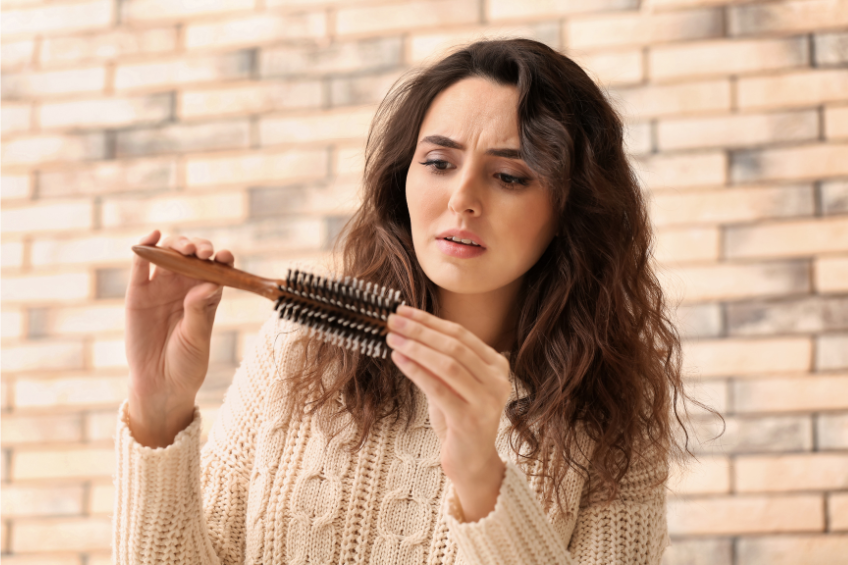For many people, a full head of hair is a source of confidence and the thought of losing it can be distressing. If you’ve noticed extra strands on your pillow in the morning or seem to be pulling out clumps of hair when you wash it, you may be concerned that your hair is thinning. But how can you know for sure?
The truth is, we are constantly losing our hair – each day, between 50 and 100 hairs fall out naturally, depending on how thick your hair is. However, there are some tell-tale signs of hair thinning that you can look out for. Signs of thinning hair include noticeable bald patches, a receding hairline, excessive hair loss, and hair breakage, among others. Read on to understand more about these signs of hair loss.
Signs of Hair Loss
Your Hairline is Receding
Androgenic alopecia is a common form of hair loss. Men are particularly susceptible to this genetic condition (1), but it can affect women as well. In men, this is referred to as male pattern baldness (MPB).
The first signs of a receding hairline start around the temples. You will notice the hairs around your temple becoming thinner and more diffuse, eventually forming the infamous “M” shape associated with MPB.
It is important to note that if you are between the ages of 17 and 30 it may simply be that your hairline is maturing – that is, it may appear to recede at the temples but usually no further than an inch or so.
A receding hairline isn’t always caused by genetics. A specific condition called traction alopecia is associated with wearing tight ponytails, braids, or cornrows (2). You may experience a full recovery by choosing a different hairstyle that doesn’t pull on your hair as much, but if nothing is done, over time the follicles will die, resulting in permanent hair loss.
Excessive Hair Loss
You may notice more hair than usual coming out when you brushing or shampoo your beloved locks. This could be a sign that your hair is thinning, but not always.
We may lose more hair than usual in response to heightened stress levels, and there are many different medications that may cause hair loss as an unwanted side effect. The good news is that stress-related hair loss is not a death sentence for your follicles. You can fully recover by managing your stress levels, so try not to worry too much about your hair loss if you can identify a situation that may be stressing you out. If you are on medication and suspect it may be causing hair loss, consult your prescribing doctor and bring this to their attention.
However, if you are experiencing more hair loss than usual and these situations don’t apply to you, it could be a sign that your hair is thinning – especially if it doesn’t seem to be letting up or is combined with some of the other signs listed here.
A Widening Part
If you part your hair down the middle and notice that more of your scalp is visible than usual, it may be a sign that your hair is thinning.
Male pattern baldness typically starts around the temples and crown and does not usually affect the sides and back of the head until more advanced stages. A widening part is a tell-tale sign that the condition is progressing. Women can experience a similar phenomenon.
Noticeable Bald Patches
Nobody knows your hair like you do, so if you have noticed a patch on your scalp where hair doesn’t seem to grow anymore it could be a sign that your hair is progressively thinning.
There are other things that can cause bald patches like infections and allergic reactions, but once the offending condition has been resolved everything should return to normal.
Clumps Of Loose Hair
As mentioned previously, it is completely normal to experience some hair loss – we lose hair every day. However, if your hair seems to come out in clumps, it might be a sign that your hair is thinning rapidly.
Pattern baldness usually progresses slowly, and is not characterized by clumps of hair loosening from your scalp. Rapid hair loss is associated with a condition called telogen effluvium, which can be triggered by hormonal changes, severe illness, and emotional trauma (3).
The good news is that those suffering from telogen effluvium usually make a full recovery by resolving the cause of distress. A healthy, balanced diet and effective stress management are key to recovery.
Conclusion
Thinning hair can present itself in many ways, depending on the cause. In some cases, it can be completely reversed by resolving the underlying issue, but in others like MPB, it can be permanent. If you are suffering from nutritional deficiencies that may be causing your temporary hair loss, consider trying a high-quality nutritional supplement such as Research Verified Hair Growth. Either way, try not to stress about your hair too much as stress can exacerbate the situation.



